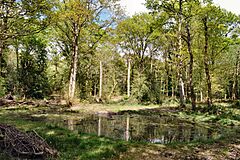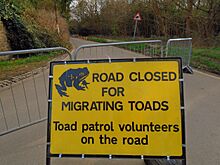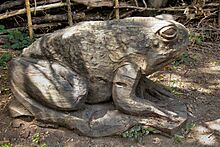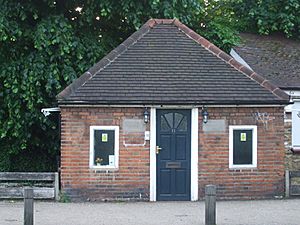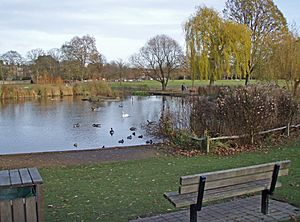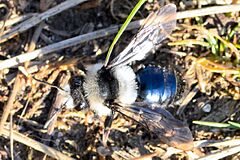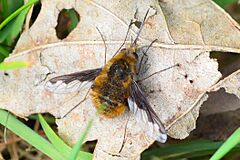Ham Common, London facts for kids
Quick facts for kids Ham Common |
|
|---|---|
 |
|
| Type | Common land |
| Location | Ham, London |
| Area | 48.69 hectares (120.3 acres) |
| Operated by | London Borough of Richmond upon Thames |
| Open | All year |
| Status | Conservation area |
Ham Common is a large open space in Ham, London, that everyone can use. It's a special conservation area, which means it's protected to keep its natural beauty and wildlife safe. The London Borough of Richmond upon Thames looks after it. Ham Common is about 48.69 hectares (120 acres) in size, making it the second largest common in the area.
The common is split into two main parts: a grassy area and a woodland, with the Upper Ham Road running between them. It's a great place for nature, history, and fun activities, and it's even called a Local Nature Reserve.
Contents
Exploring Ham Common
On the west side of Upper Ham Road, there's a big, triangular grassy area, like a village green. It's surrounded by old trees. A path, lined with trees, leads towards Ham House. You'll find a pond in this part of the common, which is a home for ducks, geese, and other wild animals.
Ham Common Woods
Across Upper Ham Road (the A307) is a bigger area called Ham Common Woods. This woodland stretches for about 1 kilometer (0.6 miles) towards Richmond Park in the east and Sudbrook Park, Petersham to the north. A road called Ham Gate Avenue goes through the woods, connecting the A307 to Richmond Park.
The Latchmere Stream starts in a pond in Ham Common Woods, near Ham Gate. Most of this stream now flows underground in a pipe. You can also see two cedar trees that were planted in 1911 to celebrate King George V's coronation.
Over the years, this wooded area has changed a lot. It used to be open grassland with plants like gorse and bracken. Now, it's mostly a mixed oak woodland. Younger birch trees are slowly being replaced by holly, yew, and oak. This part of the common has a thick layer of plants under the trees, which is different from the more open woods in nearby Richmond Park. Local groups help manage the woods, keeping paths clear and removing plants that grow too much.
There's still an open, sandy grassland area in the woods where you can find a special type of bee called the Ashy mining bee, along with other solitary bees.
Every spring, parts of Church Road near Ham Common are closed to cars. This is to protect toads as they cross the road to get to their breeding ponds. In 2017, new ponds were built to give these toads more places to live.
A Look Back in Time
Long ago, in 1637, a map made for King Charles I showed that Ham Common was much bigger than it is today. It stretched all the way to a place called Beverley Brook. When Richmond Park was created, a lot of this common land was taken for the park.
King Charles I paid money to the local people of Ham because they lost their common land. He also promised them that the remaining common land would be theirs forever. Taking away this land was one of the many unpopular things King Charles I did, which helped lead to the English Civil War. About ten years later, in 1647, Cromwell's army even camped on Ham Common.
For many years, the common land was owned by the "lord of the Manor," who was like the main landowner. From the mid-1600s to the early 1900s, this was the Earl of Dysart and his family. Later, a local group called the "vestry" (like a local council) took over managing the common.
The vestry often dealt with problems like people building on the common without permission, people living there without a proper home, or too many animals grazing. Sometimes, animals from other towns, like 200 sheep from Kingston, would even graze on the common! Gates were put up around the common to stop animals from wandering off. One of these old gate houses, built in 1771, still stands today.
Protecting Ham Common
In the late 1800s, as London grew, there was more pressure to build on Ham Common. Laws were passed to help protect these common lands.
The Dysart family, who owned the manor, tried to use the common land for farming and building. In 1891, they put up signs saying people couldn't take gravel or turf from the common without their permission. They also tried to stop people from using other common lands.
The villagers of Ham fought back! They said the Dysarts were wrong. Four men were even arrested for cutting down some of the Dysarts' signs. But with the help of a journalist named William Harry Harland, the men were found not guilty. This showed that the villagers were determined to protect their common.
In 1896, the Dysarts tried to pass a law to build on more common land, but the villagers and others stopped it. This was a big win for the people who wanted to keep the common open.
Public Ownership
A few years later, in 1902, a new law called the Richmond, Petersham and Ham Open Spaces Act was passed. This law was very important because it officially gave the ownership of Ham Common to the local council, the Ham Urban District Council. This meant the common would be managed for everyone to enjoy. The Dysart family also gave money to help take care of the common.
Interesting Buildings Nearby
Around Ham Common, you'll find many old and important buildings. Some are Listed buildings, which means they are protected because of their history or special design.
| Image | Building | Dates | Grade | History |
|---|---|---|---|---|
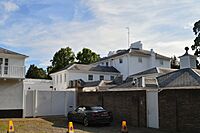 |
Park Gate House, Ham Gate Avenue |
1768 with later changes | II | This house was once home to famous people like Lord Charles Beresford. |
 |
Ormeley Lodge, Ham Gate Avenue |
Late 1600s or early 1700s | II* | This mansion was the home of James Goldsmith, a well-known financier, and his family. |
 |
Sudbrook Cottage, Ham Gate Avenue |
Early 1700s | II | The writer and playwright Beverley Nichols lived here from 1958 until he passed away. |
 |
Sudbrook Lodge, Upper Ham Road |
1680 | II* | This building was rebuilt around 1680. |
 |
The New Inn, Ham Common |
1700s | II | This pub was built in 1756, replacing an older inn. |
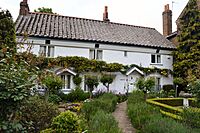 |
Stafford Cottages, Ham Common |
Early 1700s | II | These are some of the oldest buildings on the common. |
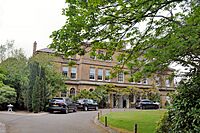 |
South Lodge, Ham Common |
1856-1862 | II | From 1838 to 1848, this was the site of a special community and school that focused on new ideas. It later became an orphanage for girls. |
 |
Hardwicke House, Ham Common |
1700s or 1800s | II | This house was designed in 1688 by Thomas Tryon, who was an early supporter of animal rights and vegetarianism. |
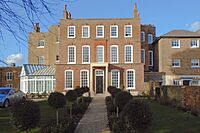 |
Orford Hall, Ham Common |
1730-1734 | II | This house was once a convent called St Michael's Convent. |
 |
Avenue Lodge, Ham Common |
Around 1734 | II | |
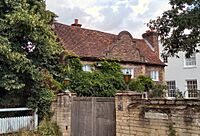 |
Avenue Lodge Cottage, Ham Common |
1679 with later work | II | |
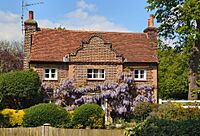 |
Avenue Cottage, Ham Common |
1600s | II | |
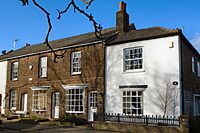 |
Boxall cottages, Ham Common |
Late 1800s | ||
 |
Vine cottage, Ham Common |
Georgian era | This building was originally two separate houses. | |
 |
Selby House, Ham Common |
Early 1700s | II | |
 |
St Thomas Aquinas R C Church, Ham Street |
Late 1880s | This church used to be a school. | |
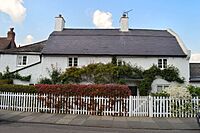 |
The Old Malt House, Lock Road |
Around 1820 | This building was used for making malt. | |
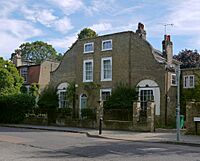 |
Ensleigh Lodge, Ham Common |
Around 1800 | II | This house was once home to Nigel Dempster, a British journalist. |
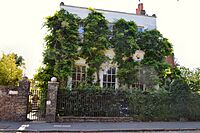 |
The Little House, Ham Common |
1700s | II | This house was home to the writer Hesba Stretton. |
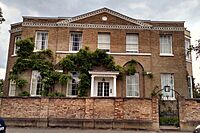 |
Gordon House, Ham Common |
1700s or 1800s | II | This house was home to Gordon Forbes, a senior officer in the British Army. |
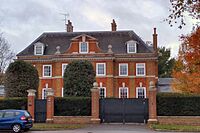 |
Forbes House, Ham Common |
Around 1996 | The original house here was once home to Claude Bowes-Lyon, 14th Earl of Strathmore and Kinghorne, who was related to the Royal Family. | |
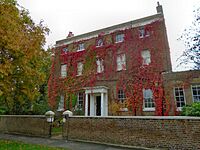 |
Langham House, Ham Common |
Around 1780 | II | |
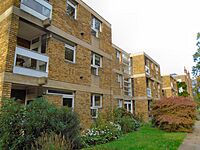 |
Langham House Close | 1956-1958 | II* | These buildings were designed by famous architects James Stirling and James Gowan. |
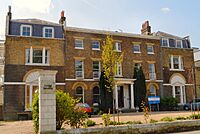 |
The Cassel Hospital, Ham Common |
1800-1820 with later additions | II | This building was once a hotel and is now a hospital. |
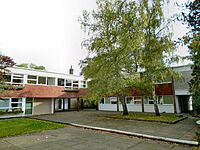 |
Parkleys Estate | 1954-1956 | II | Parkleys was one of the first large housing developments by a company called SPAN Developments. |
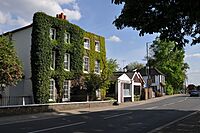 |
Ivy House, Upper Ham Road |
Mid to late 1700s | II | |
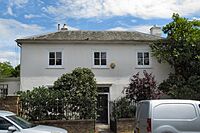 |
Fox House, Upper Ham Road |
1700s | II | |
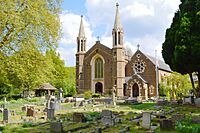 |
St Andrew's Church, Church Road |
1830-1900 | II | |
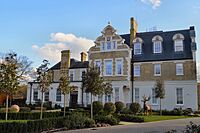 |
Latchmere House, Church Road |
Mid 1800s |
Fun on Ham Common
Ham Common is a popular spot for local people to enjoy the outdoors. There's a special track for horses that connects Richmond Park to the river. The Ham and Petersham Cricket Club plays cricket regularly on the common during the season.
Since 1984, a local group called the Ham Amenities Group has organized an annual village fair. It usually happens on the second Saturday of June and raises money for local charities. Sometimes, other fun events and fairs also take place on the common.




